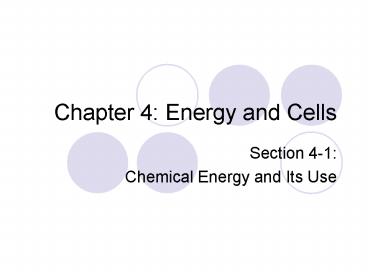Chapter 4: Energy and Cells - PowerPoint PPT Presentation
1 / 9
Title:
Chapter 4: Energy and Cells
Description:
Energy is the ability to do work. Potential ... Kinetic energy = the energy of movement. Potential energy is converted to kinetic energy (think rollercoaster) ... – PowerPoint PPT presentation
Number of Views:24
Avg rating:3.0/5.0
Title: Chapter 4: Energy and Cells
1
Chapter 4 Energy and Cells
- Section 4-1
- Chemical Energy and Its Use
2
What is ENERGY?
- Energy is the ability to do work
- Potential energy stored energy
- Kinetic energy the energy of movement
- Potential energy is converted to kinetic energy
(think rollercoaster) - In cells, potential energy is in chemical bonds
3
Rubber Band Activity
- With your partner, make a labeled drawing that
shows - How work can be done on the rubber band in such a
way that it stores energy - How that stored energy can be released to do work
4
Cells and Energy
- All energy starts at the sun
- Cells have a compound called ATP (adenosine
triphosphate) that works like a battery - Three compounds to know
- ATP adenosine triphosphate
- ADP adenosine diphosphate
- AMP adenosine monophosphate
5
ATP
6
AMP ? ADP ? ATP
- Takes a significant amount of energy to attach a
phosphate group to AMP to make ADP - Even more energy needed to make ADP to ATP
- Energy is stored in the phosphate bonds, just
like electricity in a battery
7
How does all this happen?
- Enzymes that require energy have binding sites
for ATP and similar energy-carrying molecules - When energy is needed to complete a reaction, one
phosphate group breaks off ATP converting it to
ADP dephosphorylation - ADP can now be phosphorylated
8
Releasing Energy from Food
- Animal cells get energy needed for
phosphorylation from food - The reaction of glucose and oxygen in living
cells produces CO2 and H2O, with lots of energy
given off - This energy is trapped by ATP so that it does not
burn up the cell
9
Cellular Respiration
- General equation
- C6H12O6 6O2 ? 6CO2 6H2O
- Breaking the chemical bonds between the atoms in
the glucose molecule releases the energy































